Read the title, background and three diaries quickly. Then find out the main ideas referring to the following table.
Basic information about the expedition | |
| Time | 1914.10.31→1915.11.21→1916.5.20 |
| Destination | To Antarctica |
| Leader | Sir Ernest Shackleton |
| The author’s name | Perce Blackborow |
| The ship | Endurance |
A SUCCESSFUL FAILURE
Perce Blackborow joined an expedition with Sir Ernest Shackleton to Antarctica on the ship Endurance in 1914. Shackleton was one of the most famous explorers of his day and it was considered a great honour to be part of his expeditions. Below are some of Blackborow’s diary entries.
31 Oct 1914
… Well, it so happened that one morning I bought a newspaper and read the advertisement about the Antarctic expedition.
An expedition to the South Pole with the great Sir Ernest Shackleton — this is the adventure that I have been dreaming of. And I was ready for it. At the age of 19, I am fit and full of vigour. However, when I applied to join the expedition, Shackleton turned me down because he thought I was too young and wasn’t qualified. But I was so enthusiastic about the idea of going along with them that I secretly went aboard his ship, the Endurance, and hid in a small cupboard. Unfortunately, three days after we set off I was discovered. Shackleton did not want to turn back so he offered me a job, but only after he promised me, “If anyone has to be eaten, then you will be the first!” He assigned me to be a steward, and I now serve meals for twenty-eight men, three times a day.
How everyone will envy me when I come back and tell them about the amazing places I have been to!
21 Nov 1915
The journey has not been easy. Endurance became stuck in the ice as we approached Antarctica. The ice froze around us and we were well and truly stuck! We saw the ship get crushed by the ice. And when the ship sank, our hearts sank with it.
Before we abandoned the ship, Shackleton calmly called us together and told us to rescue our most essential supplies — the small boats, our food, the cook stove, candles, clothes, and blankets. This was no time to panic. We were not allowed to take most of our personal belongings, and Shackleton himself threw away all his gold. But to our surprise, he allowed Hussey to keep his banjo. Hussey often plays it to keep our spirits up.
We are now camped on the ice and we have been managing to survive, but spring is coming, and the ice will soon begin to melt.
20 May 1916
We have been struggling for days, but things on Elephant Island are going from bad to worse. We are now crowded together under one of our boats on the rocky shore of this miserable place. Soon after we arrived, Shackleton left us to find help on South Georgia Island, 1,320 kilometres away — the voyage was too dangerous and difficult for all of us to make it in our small boats. If Shackleton fails, will we have any hope of rescue? No. No navy in the world ever stops at Elephant Island, and no one else knows that we are here.
I feel low. It’s cold and windy. The island has no plants. Sometimes we are able to catch a seal or a penguin to eat. Otherwise, there is no food. I try to think of happier things: decent food, warm and dry clothes, a cosy bedroom, sunny days, and my mother’s face… However, these happy memories are soon interrupted by a sudden cold rush of air.
I shouted, “Shut the door!”
“Hold on now, Perce. Don’t you go turning into another Tom,” came the reply. “We’ve caught another penguin, so it’s penguin soup tonight!”
Bless Frank Wild, the kindest man there is after our leader, Ernest Shackleton. How could I become as selfish and bad-tempered as Thomas Orde-Lees!
Without Frank and Ernest, we’d all be dead by now. Their genuine concern for others, their perseverance, and their resolve fill me with hope.
Perhaps there is a chance we will return home, after all.
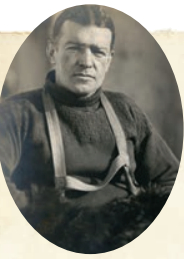
| Diary | Date | Main idea |
1 | 1914.10.31 | The first diary is about how |
2 | 1915.11.21 | The second diary is about how |
3 | 1916.5.20 | The third diary mainly describes |
2 . SEEING THE TRUE NORTH VIA RAIL: VANCOUVER AND THE HEART OF CANADA
Li Daiyu and her cousin Liu Qian went to Canada to visit their cousins in Halifax on the Atlantic coast. Rather than travel by commercial airline all the way, they decided to fly to Vancouver and then take the train. For both of them, the thought of crossing the whole country by rail was exciting.
Before starting out, they spent a couple of days in Vancouver, seeing the sights. During their first day, as is typical of Vancouver, it rained. Despite the weather, they were able to take a boat ride out into the bay, and later visit an island that had wonderful shops selling crafts and antiques. The next day was clear and mild, and they were pleased to see the beautiful mountains looking out over the city. Later, they took a pleasant hike in a forest just a short distance away.
The next morning, the two girls arose early to take the train to Lake Louise, passing through the Canadian Rockies. Seen from the train window, the mountains and forests of Canada looked massive. When the train arrived at the station, they took a taxi to Lake Louise, where the blue water literally took their breath away with its exceptional beauty. They spent the night, and then took a coach bound north through the Canadian Rockies to Jasper. Looking at the beautiful scenery, they both agreed that it was the most awesome journey they had ever taken. In addition to seeing spectacular mountain peaks and forests, one highlight of their trip was being able to see many different creatures, including deer, mountain goats, and even a grizzly bear and an eagle.
From Jasper, they caught the train towards Toronto. One of the train’s first stops was in Edmonton, the provincial capital of Alberta, the centre of Canada’s huge oil and gas drilling industry. Edmonton is freezing cold in winter, with daily temperatures averaging -10℃. Since it can be too cold to go outdoors, Edmonton is home to many shopping malls. In fact, one of the largest shopping malls in North America is in Edmonton.
From Edmonton, the train headed southeast across the great Canadian Prairie. At school, Daiyu and Liu Qian had learnt that Canada’s population is only slightly over thirty-seven million. However, they did not anticipate seeing such an open country, and were truly amazed. They went through two wheat-growing provinces, where they saw a bunch of farms that covered a very large area.
After another day on the train, eventually they were back in an urban area, the city of Winnipeg. From there, they travelled through the night, and woke up in Ontario—a land of forests and lakes. The train thundered on, through the rolling hills. The bushes and maple trees outside their windows were red, gold, and orange, and there was frost on the ground, confirming that autumn had arrived in Canada. Night came again, and the train turned south towards Toronto. When they woke up the next morning and pulled back the curtain, they could see the wide stretch of Lake Huron—one of the four Great Lakes on Ontario’s southern border. It was not until 9:30 a.m. that they finally reached the capital of Ontario, Toronto. All in all, their trip from Vancouver to Toronto had taken a duration of four days.
根据文章内容完成表格。Place | Information |
| often rains; a harbour; beautiful mountains looking out over the city; a forest just a short distance away | |
| the Canadian Rockies | |
| centre of Canada’s huge oil and gas industry; cold in winter, with daily temperatures averaging -10℃; home to one of the largest shopping malls in North America | |
| the Canadian Prairie | |
| a land of forests, lakes, and rolling hills; four Great Lakes on its southern border; capital is Toronto |
3 . After Li Daiyu and her cousin arrived in Toronto, the largest and wealthiest city in Canada, they only had a few hours to kill before they had to proceed to the next leg of their trip to Montreal, so they went on a tour of the city. They went up the CN Tower and looked across the shores of Lake Ontario. Standing in the distance, they were astonished to see misty clouds rising from the great Niagara Falls, which is on the south side of the lake. Water from the lakes flows into the Niagara River and over the falls on its way to the sea.
The girls saw hundreds of skyscrapers of glass and steel, and old-fashioned cars rolling by. As they walked north from the harbour area, Li Daiyu said, “Lin Fei, one of my mother’s old schoolmates, lives here. I should phone her and see if she’s available for dinner.”
They met Lin Fei around dusk over dinner at a restaurant in downtown Chinatown. The cousins chatted with Lin Fei, who had moved to Canada many years earlier.
“This is the largest Chinatown in Toronto. We have a few more in the Greater Toronto Area, so you can guess that there are a lot of Chinese people in Canada! Chinese people have been coming here for more than a hundred years. Therefore, we can get all kinds of great food here from all over China,” Lin Fei told them.
The train left late that night and arrived in Montreal early the next morning. At the station, in contrast to Toronto, they heard people talking in French. They were surprised to see that all the signs and advertisements were in French and many people spoke English with an accent.
“We don’t leave until this evening,” said Liu Qian. “Let’s go downtown. Old Montreal is close to the water.”
They spent the afternoon in lovely shops and visiting artists in their workplaces along St Paul Street. As they sat in a restaurant alongside the broad St Lawrence River, a young man sat down with them.
“Hello, my name is Jean-Philippe. I’m a photographer,” he said, “and I was wondering where you are from.”
The girls told him they were from China and were on a train trip across Canada. When they told him they had only one day in Montreal, he said, “That’s too bad. You owe it to yourselves to stay longer. Overall, Montreal is a city with wonderful sights and sounds. Most of us speak both English and French, and the city has unique Quebec culture and traditions. There are fantastic restaurants and clubs around, too. Here, we love good coffee, toast, and cheese. And good music, of course!”
That night the train was speeding along the St Lawrence River towards the Gulf of St Lawrence and down to the distant east coast towards the province of Nova Scotia and its largest city, Halifax. The cousins dreamt happily of the beautiful cobblestone streets, old brick buildings, and thee red maple leaves of Montreal.
1. Read the passage quickly and underline the people and places mentioned in the passage.2. Read the passage and sum up the main points of each part.
Paragraph 1-4:
Paragraph 5-9:
Paragraph 10:
3. Read the passage carefully and answer the questions.
(1)What did the girls see when they went up the CN Tower?
(2)Why was it possible to get all kinds of good Chinese food in Toronto?
(3)What did Jean-Philippe tell the girls about Montreal and the people there?
4 . REDUCING WATER POLLUTION IN THE LI RIVER
The beautiful Li River and its amazing surrounding scenery is one of the most well-known tourist destinations in China’s Guangxi Zhuang Autonomous Region. It attracts millions of domestic and foreign visitors each year. However, its reputation as a top destination has had negative effects on the river’s water quality. This report looks at the problem of water pollution and some actions that have been taken to deal with it.
Previously, water quality in the Li River had suffered greatly from an increasing volumeof tourists, many of whom frequently threw garbage into the river. Many tour boats contributed to the problem too. Kitchens on board were using lots of oil, which was often thrown into the water. The growth in tourism also meant the local population rose rapidly, as well as the number of commercial and industrial enterprises. Water pollution levels increased, with more household and commercial waste ending up in the river. In order to feed more people, more chemicals were used to increase crop production. These chemicals led to severe water quality issues, causing a decrease in the number of fish species. Local officials were concerned that the pollution was damaging the natural environment and felt that urgent steps should be taken to restore the river’s original beauty.
A comprehensive initiative was started, with a number of measures that addressed the issues. The construction of waste water treatment facilities improved the water quality and water conservation. The collection and transport of household waste was also improved. Dozens of polluting enterprises were closed or moved. The local government set up strict regulations regarding further industrial development. New rules were also introduced regarding tour boat routes and garbage disposal methods. Furthermore, the local authorities began to use the media to spread environmental awareness and encourage greater use of clean energy. At the same time, they started to carry out inspections regularly and fine tourist organisations for abuses. With these measures, it is believed that the beauty of the Li River will be preserved for generations to come.
In addition, the ambitious “Water Ten Plan” is also now tackling water pollution across the country. Other initiatives, such as the “River Chief System”, hold senior officials responsible for reducing water pollution. With such campaigns in effect, China’s waterways are heading towards a clean and sustainable future.

Paragraph 1 | Paragraph 2 | Paragraph 3 | Paragraph 4 |
Introducing the topic | Describing the | Presenting some | Presenting further |
Ben Drake, an expert on air pollution, is being interviewed on the radio. He said that smog was a severe problem in the early 20th century in Britain. At that time, Britain was experiencing a boom in industry. Factories and homes used lots of coal, which created smog. He also mentioned the heavy smog in London was particularly bad and caused over 4000 deaths in 1952. Later the UK government restricted burning coal in homes and forced factories to move away from city centers. As smog is harmful to everyone, the expert advised us to replace coal with cleaner forms of energy, use new energy-efficient vehicles and further develop green technology.
1. The expression “2. Smog became a severe problem in Britain because people at that time burnt lots of
3. The worst smog in British history happened in London in 1942.
4. The Great Smog of London claimed 5,000 lives.
5. Later, the UK government ordered people not to burn
6 . SPACE: THE FINAL FRONTIER
“Are we alone? What’s out there?” Looking up at the stars, people have always wanted to learn more about space, and scientists work hard to find answers. They make vehicles to carry brave people into space to find out the secrets of the universe. They also really wish to discover other planets that are suitable enough to support life.

Apollo 11 Moon Landing
Before the mid-20th century, most people felt travelling into space was an impossible dream. However, some scientists were determined to help humans realise their dream to explore space. After many experiments, they succeeded in making rockets that could escape Earth’s gravity. On 4 October 1957, the Sputnik 1 satellite was launched by the USSR and successfully orbited around Earth. Afterwards, the USSR focused on sending people into space, and on 12 April 1961, Yuri Gagarin became the first person in the world to go into space. Over eight years later, on 20 July 1969, American astronaut Neil Armstrong stepped onto the moon, famously saying, “That’s one small step for [a] man, one giant leap for mankind.” Following this, many more goals were achieved. For example, America’s NASA space agency launched Voyager 1 on 5 September 1977 to study deep space, and it still transmits data today.
Although scientists try to make sure nothing goes wrong, accidents can still happen. All the astronauts on the USSR’s Soyuz 11 and America’s Challenger died during their missions. These disasters made everyone sad and disappointed, but the desire to explore the universe never died. This is because people believe in the importance of carrying on space exploration despite the huge risks. An example of this ongoing work is the International Space Station. It orbits Earth and has astronauts from different countries on board, providing a continuous human presence in space.
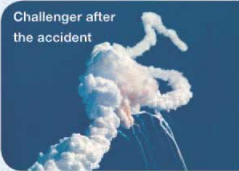
Challenger after the accident
China’s space programme started later than those of Russia and the US, but it has made great progress in a short time. China became the third country in the world to independently send humans into space in 2003, when Yang Liwei successfully orbited Earth in the Shenzhou 5 spacecraft. Then Shenzhou 6 and 7 completed a second manned orbit and the first Chinese spacewalk, followed by the vehicle Jade Rabbit being sent to the moon to study its surface. After that, China launched the Tiangong 2 space lab into space and Tianzhou 1 to dock with it. This signalled one step further in China’s plan to establish a space station in the future. More recently, China has sent Chang’e 4 to explore the surface of the far side of the moon to make measurements and observations.

Jade Rabbit
The future of space exploration remains bright. Europe, the US, and China all have plans to further study and explore planets like Mars and Jupiter. Despite the difficulties, scientists hope future discoveries will not only enable us to understand how the universe began, but also help us survive well into the future.
1. 将每一段与其主旨大意相匹配。| A. Plans to further study. B. The risk of exploring the space. C. The development of space exploration. D. Human’s desire to explore the space. E. China’s space programme. |
Para. 2
Para. 3
Para. 4
Para. 5
2. 阅读第二到第四段并填写表格。
| The development of space exploration | On 4 October 1957, the USSR |
| On 12 April 1961, Yuri Gagarin became the | |
| On 20 July 1969, American astronaut Neil Armstrong | |
| On 5 September 1977, America’s NASA space agency | |
| The risk of exploring the space | All the astronauts on the USSR’s Soyuz 11 and America’s Challenger were |
| The desire to | |
| People believe in the | |
| China’s space programme | In 2003, Yang Liwei successfully |
| Then Shenzhou 6 and 7 completed a second manned orbit and the first Chinese | |
| China launched the Tiangong 2 space lab into space and Tianzhou 1 to | |
| More recently, China has sent Chang’e 4 to explore the |
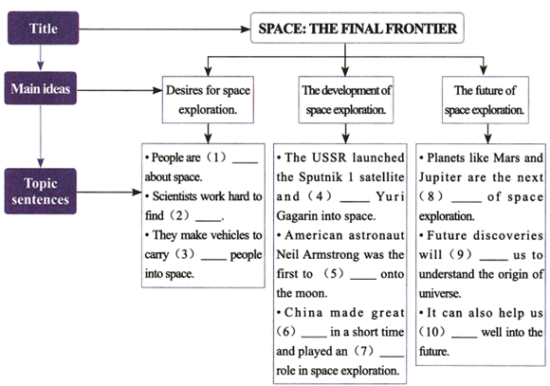
(2)
(3)
(4)
(5)
(6)
(7)
(8)
(9)
(10)
4. 根据课文内容填空。
From the passage, we know that people have
7 . FIRST AID FOR BURNS
The skin is an essential part of your body and is its largest organ. Your skin acts as a barrier against disease, toxins, and the sun’s rays. It also helps control your body temperature, prevents your body from losing too much water, warns you when things are too hot or cold, and gives you your sense of touch. As you can imagine, getting burnt can lead to very serious injuries. The first and most important step in the treatment of burns is giving first aid.
CAUSES OF BURNSYou can get burnt by a variety of things: hot liquids, steam, fire, radiation, the sun, electricity, acids, or other chemicals.
TYPES OF BURNSBurns are divided into three types, depending on the depth of skin damage.
● First-degree burns These affect only the top few millimetres of the skin. These burns are not serious. Examples include mild sunburn and burns caused by other minor household incidents.● Second-degree burns These go below the top layer of the skin. They are serious and take a few weeks to get better. Examples include burns caused by hot liquids.
● Third-degree burns These affect every layer of the skin, and sometimes the tissue under it. Examples include burns caused by electric shocks, burning clothes, or petrol fires. These burns cause very severe internal injuries and the victim must go to the hospital at once.
CHARACTERISTICS OF BURNS
| First-degree burns ● dry, red, and mildly swollen ● mildly painful ● turn white when pressed Second-degree burns ● red and swollen; blisters; watery surface ● extremely painful | Third-degree burns ● black and white ● swollen; the tissue underneath can often be seen ● little or no pain if nerves are damaged; may be painful around the edges of the burned area |
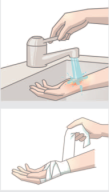
1 Place burns under cool running water, especially within the first ten minutes. The cool water stops the burning process and reduces the pain and swelling.
2 Dry the burnt area gently with a clean cloth.
3 Remove any clothes using scissors if necessary, unless you see the fabric sticking to the burnt skin.
4 Cover the burnt area with a loose clean cloth. Applying oil to the injured areas is a bad idea, as it will keep the heat in the wounds and may cause infection.
5 If burns are on the face, make sure the victim can still breathe.
6 If the victim is suffering from second or third-degree burns, there is an urgent need to take him/her to the hospital at once.
1. 根据文章判断下列说法的正误。(1) Your skin gives you protection from many dangerous things.
(2) A first-degree burn has this name because it is the most serious.
(3) Second-degree burns can be the most painful kind of burn.
(4) It is important to use cool water to stop the heat from remaining in the wound regardless of the degree of the burn.
(5) Putting butter or oil on burns helps because it may reduce swelling and ease discomfort.
2. 根据课文内容完成以下表格。
| Details | Types | ||
First-degree burns | Second-degree burns | Third-degree burns | |
| Depth | |||
| Characteristics | dry, red, and mildly mildly turn | red and swollen; extremely | black and white; swollen; |
| Treatment | place under | ||
After I attended your summer camp about health and lifestyle choices, I realised I hardly ever felt well, either physically or mentally. I often felt sleepy and dizzy, and lacked passion. Most worrying, though, I got the flu easily and experienced many toothaches, too.
At the end of the camp I heard, "Change the world by changing yourself." This stimulated my motivation. A dentist once examined me and told me that too much sugar in my meals had damaged my teeth and health. I made up my mind to change two things in my life: to eat nothing with sugar and to exercise regularly.
After that I stopped buying all the sweets, biscuits, and sugary drinks that I used to have every day. Whenever I went out with friends. I brought snacks from home, things that didn't have any added sugar: fruit, nuts, dried meat, etc.
My exercise was very simple: I went outside every day for at least 30 minutes and did something active. Sometimes I played table tennis or badminton with my cousins. Other times I jumped on my skateboard and rode around my neighbourhood, or just took a long walk.
The results have been fantastic. I feel more dynamic and stronger than ever, in both body and mind.I sleep soundly at night now. I no longer suffer from a flu virus or toothaches either. Best of all, in my opinion, is how I feel about myself. I feel like I'm in control of my own life. To make choices about myself is within my own power. I CAN change myself. I just need to try.
Yours truly,
Wang Lu
Dear Editor,As I took part in the summer camp about personal life choices, I started to analyse my choices, especially what I did to relax and how it was affecting my whole life.
After starting high school, I felt stressed out and always relaxed by playing computer games. I got so absorbed that I played the games day and night. Playing was fun, but I felt even more worn out afterwards! So after the camp, I realised that it was very, very important to adjust my lifestyle. I decided to take control of my life and find other ways to relax.
It was a big struggle not to join my friends in playing online games as I'm mad for them. However, I realised that to succeed in quitting, I had to replace it with something else. So I thought about what to try. Rock climbing, bowling, watching comedies, and playing basketball were the things I thought of doing instead.
Now my dad and I go rock climbing together monthly! It has enhanced the quality of my life, improving my health and increasing my happiness. I get refreshed through climbing, spend more time with my dad, and get to meet new friends.
After six months of trying out new ways of relaxing, I feel much more energetic. I feel that I can change myself for the better. And if that's true for me, then it might truly be possible to change the world for the better. As Gandhi said," Be the change you want to see in the world."
Sincerely,George Fielding
1. 阅读文章,总结文章主旨大意。
These are two
| Wang Lu | George Fielding | |
| Problem | did not feel felt got | felt felt even more |
| Decision | to to | to |
| Action | stopped exercises every day for | goes |
| Result | more sleeps feels like | feels much more feels he can |
9 . The skin is an essential part of your body and is its largest organ. Your skin acts as a barrier against disease, toxins, and the sun’s rays. It also helps control your body temperature, prevents your body from losing too much water, warns you when things are too hot or cold, and gives you your sense of touch. As you can imagine, getting burnt can lead to very serious injuries. The first and most important step in the treatment of burns is giving first aid.
CAUSES OF BURNSYou can get burnt by a variety of things: hot liquids, steam, fire, radiation, the sun,electricity, acids, or other chemicals.
TYPES OF BURNSBurns are divided into three types, depending on the depth of skin damage.
• First-degree burns These affect only the top few millimetres of the skin. These burns are not serious. Examples include mild sunburn and burns caused by other minor household incidents.• Second-degree burns These go below the top layer of the skin. They are serious and take a few weeks to get better. Examples include burns caused by hot liquids.
• Third-degree burns These affect every layer of the skin, and sometimes the tissue under it.Examples include burns caused by electric shocks, burning clothes, or petrol fires. These burns cause very severe internal injuries and the victim must go to the hospital at once.
CHARACTERISTICS OF BURNS
First-degree burns
• dry, red, and mildly swollen
• mildly painful
• turn white when pressed
Second-degree burns
• red and swollen; blisters; watery surface
• extremely painful
Third-degree burns
• black and white
• swollen; the tissue underneath can often be seen
• little or no pain if nerves are damaged; may be painful around the edges of the burn
FIRST-AID TREATMENT
1. Place burns under cool running water, especially within the first ten minutes. The cool water stops the burning process and reduces the pain and swelling.
2. Dry the burnt area gently with a clean cloth.
3. Remove any clothes using scissors if necessary, unless you see the fabric sticking to the burnt skin.
4. Cover the burnt area with a loose clean cloth. Applying oil to the injured areas is a bad idea, as it will keep the heat in the wounds and may cause infection.
5. If burns are on the face, make sure the victim can still breathe.
6. If the victim is suffering from second or third-degree burns, there is an urgent need to take him/her to the hospital at once.
1. 阅读文章,完成以下语篇结构
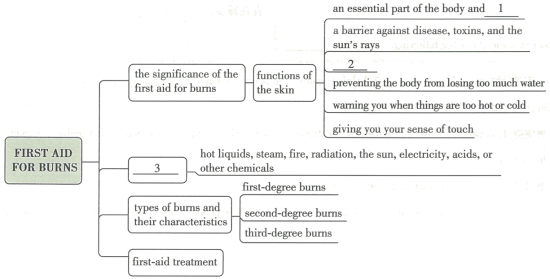
2. Which kind of burns is usually considered to be caused by hot liquids?
| A.First-degree burns. | B.Second-degree burns. |
| C.Third-degree burns. | D.Not mentioned. |
| A.Dry, red and mildly swollen. | B.Black, white and mildly painful. |
| C.Red and swollen with watery surface. | D.Black, swollen and extremely painful. |
| A.Applying oil to the burns. | B.Cooling burns immediately. |
| C.Drying the burned area gently. | D.Removing clothing if necessary. |
Chen Wei, a high school student in Beijing, had his dinner interrupted when he heard someone screaming from another table. A fellow diner at the restaurant, Zhang Tao, was choking on some steak. He was now holding his throat with his face turning red, while his desperate friends were slapping him on the back.
Chen wasted no time. He got up and ran to Zhang’s table at once. With the help of Zhang’s friends, he was able to help Zhang to his feet. Then, standing behind Zhang, Chen did the Heimlich manoeuvre. The food was instantly forced out, and Zhang began to breathe again. Ten minutes later, an ambulance arrived. The doctors checked Zhang and made sure that he was fine. They suggested he eat more slowly and take smaller bites before they left.
Choking victims usually have only about four minutes before they collapse and sometimes die, leaving no time for an ambulance to arrive. To solve this problem, in 1974, an American doctor, Henry Heimlich, created the Heimlich manoeuvre, saving thousands of lives around the world. Doing the Heimlich manoeuvre is quick, practical, and easy. It is so easy, in fact, that almost anyone can learn how.
If you see someone choking, first call the emergency services. Then, make sure that the victim is really choking: A choking person cannot speak. Slapping the victim’s back will often force out the obstruction. If this does not work, you can perform the Heimlich manoeuvre by standing behind him and wrapping your arms around his waist. Make a fist with one hand and place it in the upper part of his stomach. Grabbing your fist with your other hand tightly, push up and into his stomach in one motion. Continue doing this until the obstruction is forced out.
Doing the Heimlich manoeuvre on a small child is not recommended, as you may hurt him. Instead, lay the child face down on your lap with the head lower than the rest of his body, and then give firm slaps to his upper back until he can breathe again.
With choking victims, every minute counts. You cannot just stand by and do nothing. Luckily, Chen had learnt how to give first aid in school. Seeing Zhang choking, he remained calm and reacted immediately. Chen later said about the incident, “How could I justify sitting there and doing nothing? We are all humans and we all have a responsibility to look after one another’s welfare.”
1. Chen Wei was a friend/complete stranger to Zhang Tao.2. When Chen Wei reached Zhang Tao, Zhang Tao was sitting on the chair/standing.
3. The Heimlich manoeuvre is quite easy/difficult to do.
4. You will know that the victim is choking if he cannot speak/stops breathing.
5. To help a small child who is choking, you need to lay the child face up/down on your lap and slap his upper back.
6. Chen Wei was able to save Zhang Tao because he learnt the Heimlich manoeuvre at school/from a first-aid manual.



